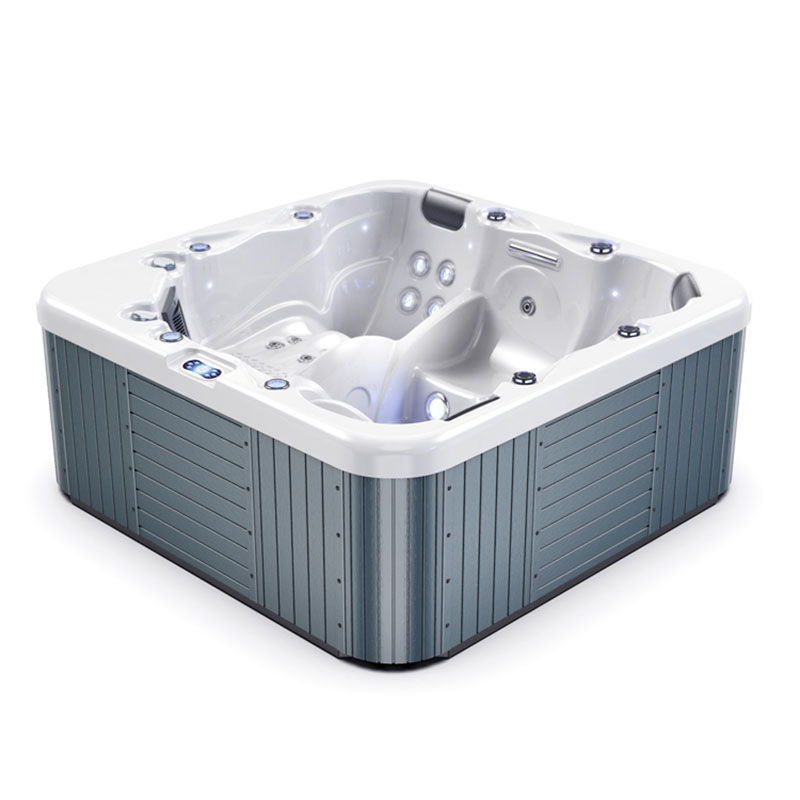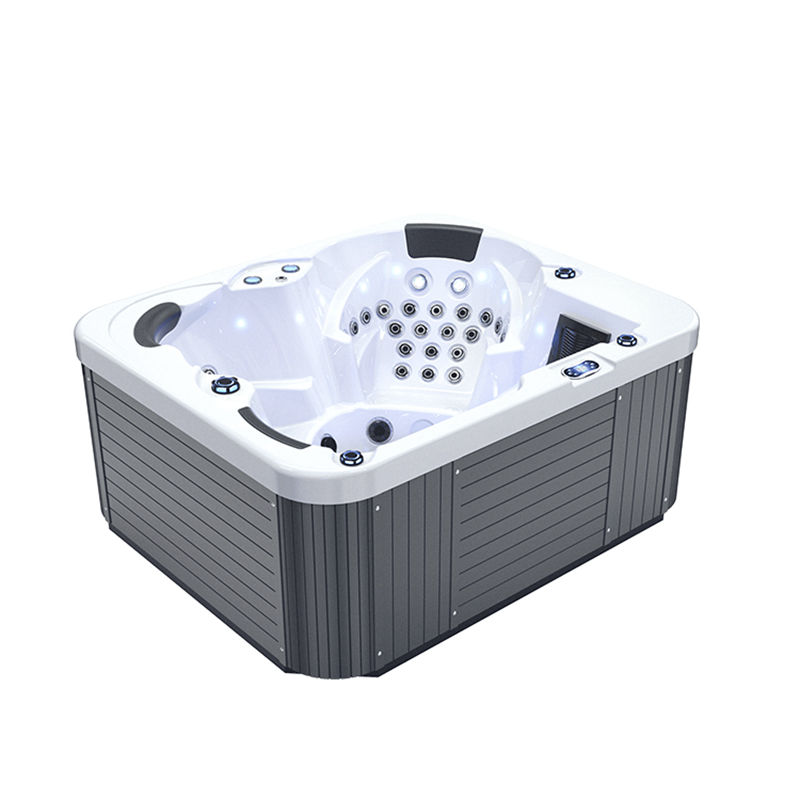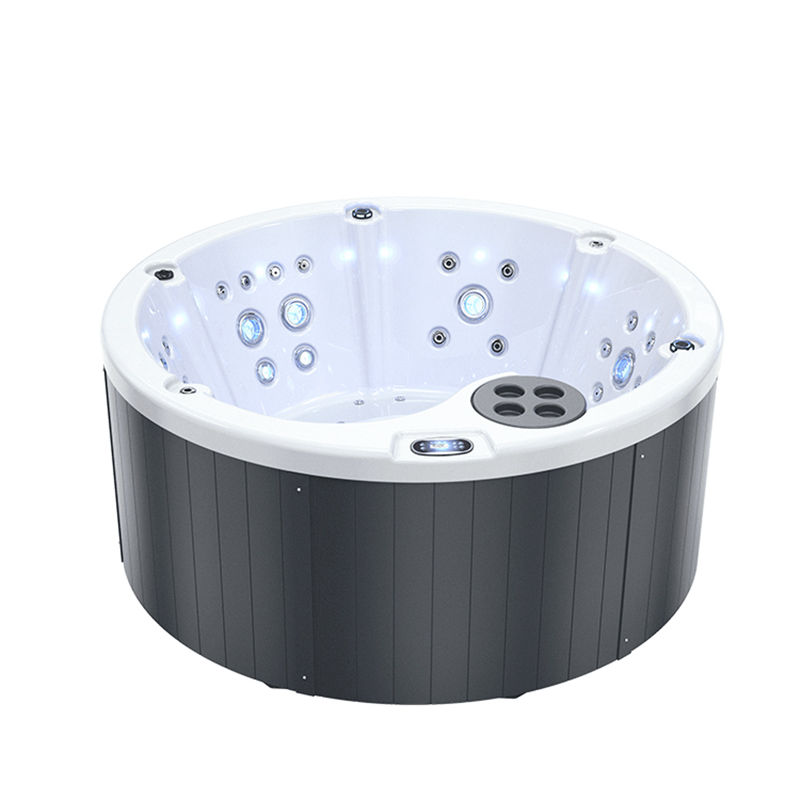Among the many hydrotherapy equipment, swim spas and jacuzzi tubs are the two most common types. Although both provide a hydrotherapy experience, their design intentions, functions, and applicable groups are significantly different. For consumers, understanding the difference between swim spas and jacuzzi tubs can help make a more informed purchasing decision.
This article will provide a detailed comparison of the two devices from many aspects to help readers more clearly understand their respective features and differences.
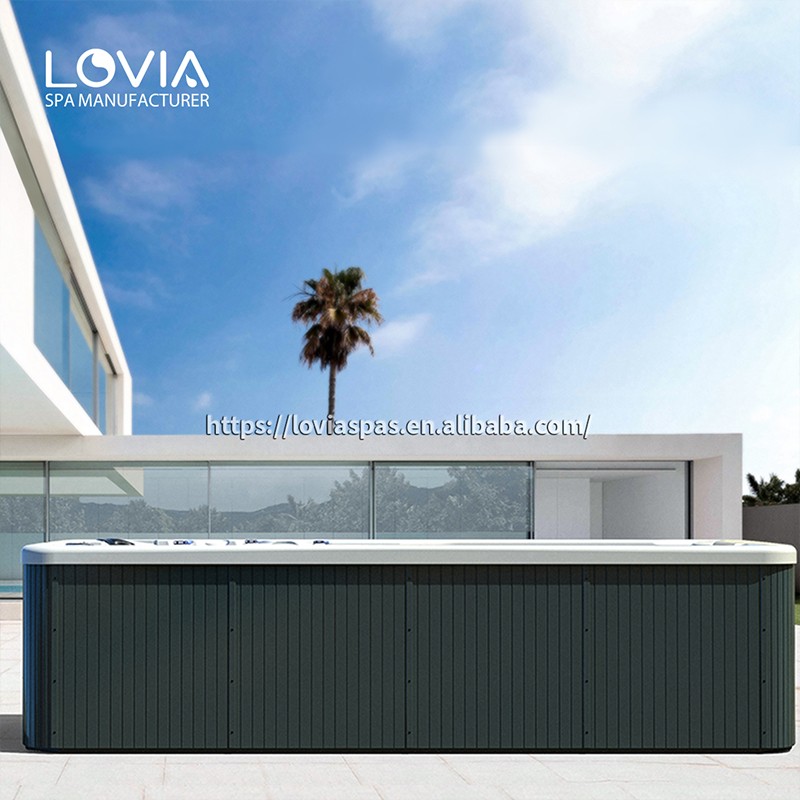
Swim Spa and Jacuzzi Tub: Differences in Functions and Uses
Swim spa:
The design of a swim spa is to provide users with a multi-functional device that combines swimming exercise and hydrotherapy massage. Its main feature is that it has a small swimming area, which usually generates a constant water flow through a powerful jet system, and users can swim in this opposing water flow. The jet system of the swim spa can adjust the intensity of the water flow according to demand, which is suitable for people of different swimming levels. In addition, the swim spa also includes a hydrotherapy massage function, which provides water flow massage through the massage jets to help relax muscles and relieve stress.
The dual functions of the swim spa make it an ideal choice for those who want to balance fitness and relaxation. It can not only be used for swimming exercise, but also provide a comfortable massage experience like a traditional hot tub. This makes it highly attractive in the market, especially for those who want to enjoy swimming and hydrotherapy at home.
Jacuzzi tub:
The jacuzzi tub is mainly designed as a device to provide hydrotherapy massage. Its core function is to produce hydromassage effects of different intensities through built-in water flow and air flow nozzles. The nozzles of the jacuzzi tub are usually distributed in different positions of the bathtub, targeting specific parts of the human body, such as the back, legs, neck, etc., to provide deep hydrotherapy massage and relieve muscle fatigue and tension.
Unlike the swim spa, the jacuzzi tub does not provide the function of swimming exercise. Its main purpose is to relax, relieve stress and treat muscle soreness, suitable for those who pursue a comfortable and relaxing experience. Although the jacuzzi tub also comes in different sizes, it is usually not suitable for large-scale physical activities, but more suitable for sitting-style relaxation and enjoying hydrotherapy.

Swim Spa and Jacuzzi: Difference in Design and Size
Swim spa:
The size of the swim spa is larger, usually between a small swimming pool and a hot tub. Depending on the model and brand, the length of a swim spa can range from 10 feet (about 3 meters) to 20 feet (about 6 meters) and the width is about 6 to 8 feet (about 1.8 to 2.4 meters). Its larger size not only provides enough space for users to swim, but also reserves a part of the area for hydrotherapy. Usually, the swimming area and massage area of a swim spa are separated, and users can choose different functions according to their needs.
This larger design means that a swim spa usually requires more space, whether it is an outdoor courtyard or an indoor space, there must be enough area to accommodate it. Its large size also makes its installation and transportation more complicated.
Jacuzzi tub:
In contrast, the jacuzzi tub is usually more compact in design and smaller in size than a swim spa. Depending on the model, the size of a jacuzzi tub can range from a small bathtub for 2 to 4 people to a large bathtub for 8 to 10 people. It is usually no more than 7 to 8 feet (about 2.1 to 2.4 meters) in length and is also smaller in width. The core of the design of a jacuzzi tub is to provide users with a comfortable and relaxing space, so in terms of space allocation, more attention is paid to the hydrotherapy experience rather than the swimming function.
Due to its small size, the jacuzzi tub can be installed more flexibly in a variety of different environments, including indoors, on a terrace or in a courtyard. It is relatively easy to install and does not require complex foundation and power system support like a swim spa.
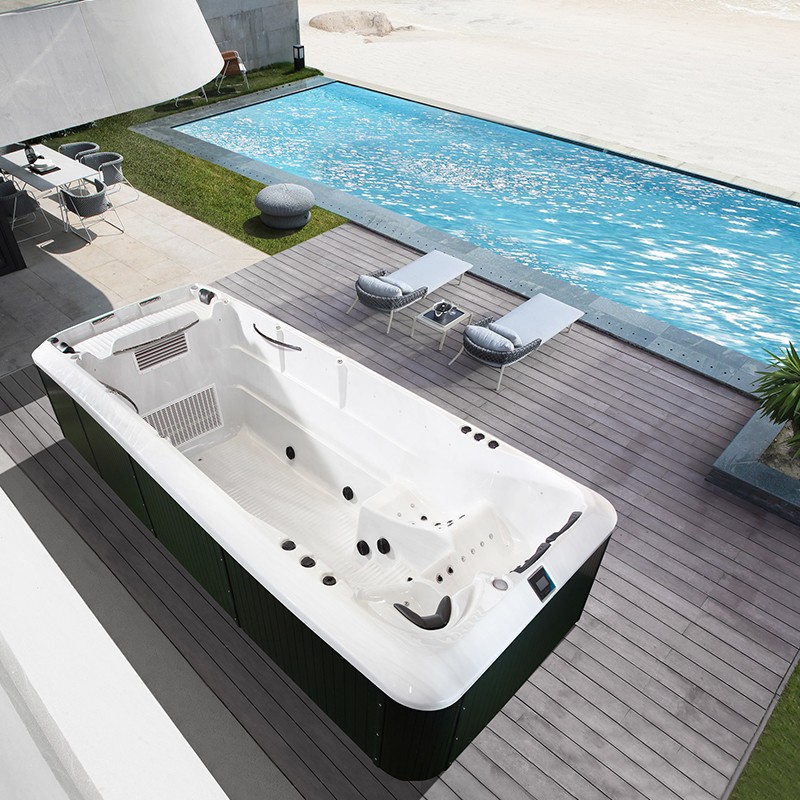
Swim Spa and Jacuzzi: Differences in User Experience and Applicable People
Swim spa:
One of the main features of a swim spa is that it provides the function of swimming. This equipment generates a continuous water flow through a jet system, allowing users to exercise swimming in a small space. For those who like swimming but do not have enough space to install a traditional pool, a swim spa is an ideal alternative. It not only provides fitness functions similar to a swimming pool, but also can adapt to people of different swimming levels by adjusting the intensity of the water flow.
In addition, a swim spa is also suitable for those who want to combine swimming and hydrotherapy. For fitness enthusiasts, swimming trainers or those who need rehabilitation treatment, a swim spa can provide an integrated fitness and rehabilitation experience.
Jacuzzi tub:
Unlike the multifunctional design of a swim spa, the experience of a jacuzzi tub is more focused on hydrotherapy. Its jet system is specially designed to provide users with a full-body water massage, stimulating muscles and joints through water and air flow, relieving stress and pain. The jacuzzi tub experience is more static, and users usually choose to sit or lie in the tub and enjoy the warm water massage.
The jacuzzi tub is perfect for people who want to relax, relieve muscle tension or relieve the stress of daily life. It is also widely used in the field of health and rehabilitation, especially for those who need therapeutic massage, such as arthritis patients, sports injuries, etc.
Swim Spa and Jacuzzi: Differences in Operation and Maintenance
Swim spa:
Due to the many functions of a swim spa and the relatively large water volume, its operation and maintenance costs are usually higher. The water volume of a swim spa can reach 1,000 to 2,500 gallons (about 3,800 to 9,500 liters), requiring a powerful heating system and a constantly running filtration system to keep the water clean. This means that it takes longer to heat up and requires more electricity and water treatment chemicals.
In addition, the system of a swim spa is more complex, including water flow control devices, multiple pumps and jets. These devices require regular inspection and maintenance to ensure they operate properly. Due to the complexity of the equipment, repairs are relatively expensive, especially when there is a problem with the water flow system or heater, which usually requires professional repairs.
Jacuzzi tub:
In contrast, jacuzzi tubs are relatively simple to operate and maintain. Due to the smaller amount of water (usually 300 to 600 gallons, about 1,100 to 2,200 liters), the heating and filtration systems are also less work. This means that it takes less time to heat up, and the power consumption and water treatment costs are relatively low.
Maintenance work for jacuzzi tubs mainly focuses on cleaning the filtration system, replacing water treatment chemicals, and regularly cleaning the jets. Due to the simplicity of the system, users can easily complete these maintenance tasks themselves. Even if a malfunction occurs, the cost and difficulty of repair are much lower than that of a swim spa.
Swim Spa and Jacuzzi: Differences in Installation and Space Requirements
Swim spa:
Due to the large size of the swim spa, its installation requirements are relatively complex, and it is usually necessary to plan the installation site and supporting facilities in advance. Swim spas usually require a solid foundation to support their large weight, especially when filled with water, the weight of the equipment may exceed several tons. In addition, its power system and water pipe system also need to be installed by professionals to ensure the normal operation of the heating system and filtration system.
Swim spas have high space requirements, especially for outdoor installations. Users need to ensure that there is enough space to place the equipment and take into account factors such as sun exposure, wind and rain and other natural conditions. If it is an indoor installation, it is also necessary to ensure that the size of the room is large enough and can withstand the weight of the equipment and water pressure.
Jacuzzi tub:
The installation of jacuzzi tubs is relatively simple, and many models can be placed directly on the ground or platform without special foundation preparation. Due to its small size, it can be flexibly installed indoors or outdoors, such as in the bathroom, terrace or backyard. Jacuzzi tubs usually only require a standard power supply and simple water pipe connections, so the installation cost is low and the time is short.
In terms of space requirements, jacuzzi tubs occupy a smaller area, so they are more suitable for homes or apartments with limited space. Due to its lightweight design, even a small patio or terrace can accommodate a jacuzzi tub without placing an excessive burden on the structure.

Swim Spa and Jacuzzi: Differences in Energy Consumption and Environmental Performance
Swim spa:
Swim spas have higher energy consumption, especially when the heating and water flow systems are in operation. Due to the large amount of water, the heating system needs to run for a long time to raise the water temperature to the ideal state, which can result in considerable electricity bills for those users who keep the heating system on for a long time. In addition, the water flow system and filtration system also need to run frequently to keep the water clean and flowing, which further increases electricity consumption.
Due to the higher energy consumption, swim spas are relatively poor in terms of environmental performance. Although some advanced swim spa equipment is equipped with energy-saving technologies, such as more efficient heaters and pumps, the overall energy consumption is still higher than that of jacuzzi tubs.
Jacuzzi tub:
The energy consumption of a jacuzzi tub is lower, mainly due to its small water volume and short heating time. In addition, the water flow system and filter of a jacuzzi tub run less frequently and are usually only activated when in use, which greatly reduces electricity consumption. For those who are concerned about environmental protection and energy costs, jacuzzi tub is undoubtedly a more energy-efficient choice.
In summary, there are significant differences between swim spa and jacuzzi tub in terms of function, design, running cost and applicable population. Swim spa is more suitable for those who want to combine swimming exercise and hydrotherapy massage, especially fitness enthusiasts and swimming enthusiasts. In contrast, jacuzzi tub focuses more on the experience of hydrotherapy massage and is suitable for users who want to relax, relieve stress and treat muscle soreness.
Looking for a reliable supplier of outdoor hot tubs and swim spas?
Guangzhou HuanTong Industrial is your trusted choice. As a top-5 spa brand in China since 2019, our factory manufactures over 1,200 units monthly, ensuring stable wholesale supply and fast delivery. Whether you are sourcing for high-end wellness centers or affordable residential solutions, we offer high quality, low price options with full customization. Request your best quotes today and discover why international clients choose our factory-direct swim spa solutions.


